The Health of the Maori Language in 2006 - Te Puni Kokiri
The Health of the Maori Language in 2006 - Te Puni Kokiri
The Health of the Maori Language in 2006 - Te Puni Kokiri
You also want an ePaper? Increase the reach of your titles
YUMPU automatically turns print PDFs into web optimized ePapers that Google loves.
13<br />
FIGURE 1: CHANGES IN VALUES SEGMENTATION AMONGST MÄORI ADULTS<br />
80<br />
70<br />
Percentage (%)<br />
60<br />
50<br />
40<br />
30<br />
20<br />
2001<br />
<strong>2006</strong><br />
10<br />
0<br />
Cultural developers<br />
Mäori only<br />
Un<strong>in</strong>terested Mäori<br />
Segmentation<br />
Source: Attitudes Survey 2000, Attitudes Survey <strong>2006</strong>.<br />
Specific Shifts<br />
<strong>The</strong>re have been positive shifts among Mäori people <strong>in</strong> response to some specific value statements<br />
about <strong>the</strong> Mäori culture <strong>in</strong> general, and attitudes towards various aspects <strong>of</strong> Mäori language<br />
acquisition and use.<br />
TABLE 1 – CHANGES IN ATTITUDES OF MÄORI ADULTS TOWARDS THE MÄORI<br />
LANGUAGE BETWEEN 2000 AND <strong>2006</strong><br />
Category Value statements % <strong>in</strong> % <strong>in</strong> shift<br />
2000 <strong>2006</strong><br />
New Zealand <strong>The</strong> more New Zealanders that understand <strong>the</strong> 76 81 +5<br />
identity and Mäori culture, <strong>the</strong> less racial tension we would<br />
Mäori culture have<br />
Mäori culture is part <strong>of</strong> everybody’s heritage 61 68 +7<br />
I really want to be <strong>in</strong>volved with th<strong>in</strong>gs to do 73 84 +11<br />
with <strong>the</strong> Mäori culture

















